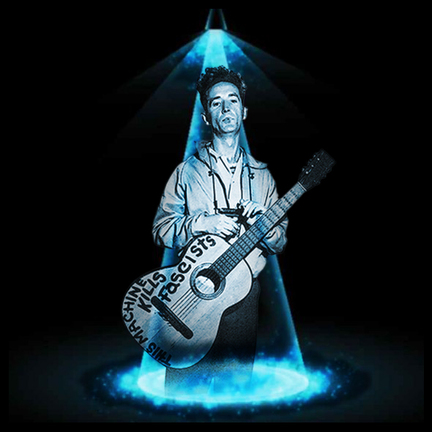|
My two most productive research interests seem quite different. My current dissertation project investigates the cultural histories and spatial embodiment of holograms and hologram simulations. In my copious free time (cough, sputter), I also maintain a course of study that began well before my grad-school adventure; as a journalist, both in Tulsa, Okla., and at the Chicago Sun-Times, I wrote a great deal about folksinger Woody Guthrie and the revival of his legacy within his home state, and now as a scholar I continue examining the ol' cuss and his peculiar communication strategies. One interest is old, analog, and sepia-toned; the other is shiny, digital, and futuristic. But — as I explained in my presentation this weekend at the Woody Guthrie Symposium, hosted jointly by The University of Tulsa and the Woody Guthrie Center — there's actually a bit of Venn-diagram shade between the two. What interests me about these emerging "hologram" technologies, especially uses of the tech in pop-music performance contexts, is how the digitally projected characters achieve some semblance of believability, how their creators manage to craft a successful performing persona, and whether these simulations can claim something like Benjamin's "aura" or even Bazin's "fingerprint." This is not far removed, I'd say, from the process human performers go through in crafting their own performing personas — which is what I claim Woody did during his two years on L.A. radio beginning in 1937, as a direct result of his encounter with the new mass medium and its delayed feedback channels. Such is the basis of my paper on the subject, and my talk this weekend. No one, to my knowledge, yet has proposed that Woody be among the legions of dead musicians resurrected in hologram form. This sounds like both a terrific idea (he'd probably love it) and a dreadful idea. Who knows? This weekend's symposium was intellectually rich. I spoke at the first Woody Guthrie Symposium in 2012, and this one seemed more well-rounded, diverse, lively. Highlights included Will Kaufman's discussion of Woody as an icon of modernity and Mark Fernandez plumbing Woody's opinions and lyrics about the atomic bomb. Gus Stadler presented an elegant narrative about Woody's awareness of his own body, both in and out of the context of his Huntington's disease. Jeff Place, from the Smithsonian, initiated an illuminating conversation about copyright by playing certain Woody songs side-by-side with the old country music melodies he'd cribbed. Last but very much not least, the inimitable David Amram closed the day with his ever-optimistic outlook and few bars on various woodwinds from around the world.
A day with the Woodygentsia is always a happy day. All this took place on the campus of The University of Tulsa, which recently acquired — in addition to its own Woody Guthrie holdings and its relationship with the city's Woody Guthrie Center — the archives of Bob Dylan. Add that to the Center's Phil Ochs collection and the university's extensive James Joyce collection, and you've got the heart of what could become a culture-archival center of gravity. More power to it.
0 Comments
Leave a Reply. |
this blahg
I'm THOMAS CONNER, Ph.D. in Communication & STS, and a longtime culture journalist. Categories
All
Archives
June 2024
|


 RSS Feed
RSS Feed